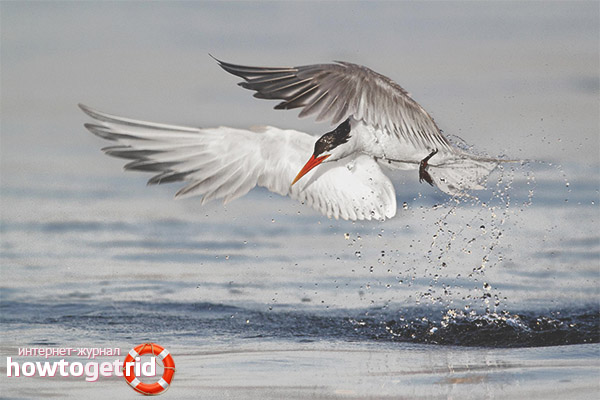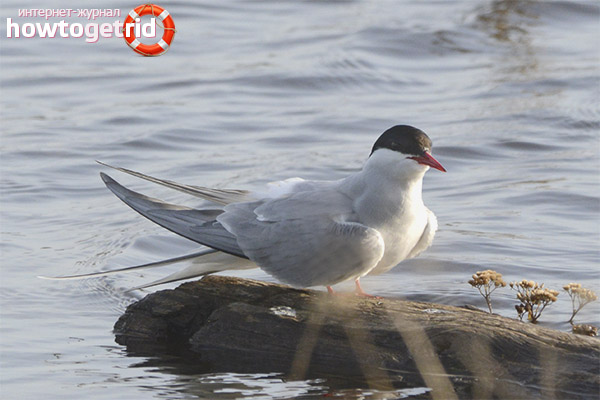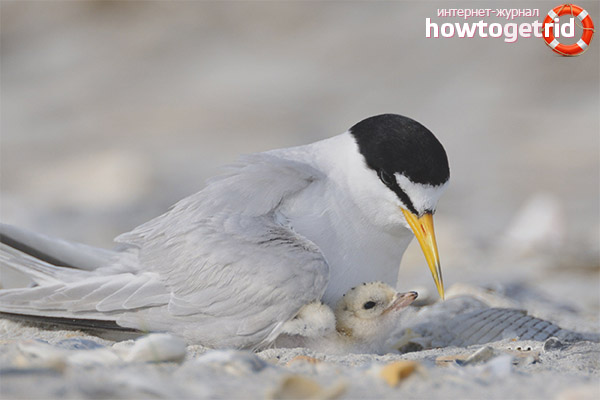The content of the article
Life also exists in the cold Arctic territories, and many fauna representatives are very comfortable there. Here, polar terns, who are part of the family of terns, have found refuge because of the direct and long beak, which has a hooked tip. And they feel good in frosty conditions.
Appearance
If it weren’t for a shorter body and longer wings, one could take the Arctic Tern for a seagull. The body length is from 35 to 42 cm, the bird weighs from 90 to 130 grams, its wingspan is from 74 to 84 cm. Since the wings are elongated, it seems that the bird is much longer.
To recognize the polar tern is simply due to the contrasting plumage: the body is snow-white, only the breast, back and wings of shades are noticeably darker. The tail is also white above and grayish below, fork-like. The head is noticeable - with a black cap. However, in winter, the forehead becomes completely white. Frontal plumage reaches the nostrils. The bird is decorated with a dark red beak, evenly colored. The head has an angular shape.
The legs are short, and between the fingers are marked membranes. The gait of the polar tern is distinguished by the fact that it walks overwhelmed due to short legs.
Male and female are very similar - in size, color. Sexual dimorphism is not inherent in them. But young growth is easily distinguishable, since in the first year of life:
- the back is painted in brown motley shades;
- much shorter tail.
In the second year, these differences disappear, and mature chicks are no different from their parents.
The voice in birds is very sharp, piercing.
Power Features
Like other inhabitants of the coastal zone, terns observe other birds when they hunt, and find schools of small-sized fish. Using someone else's observation, the tern begins to hunt in this place.
As a food, she prefers small fish and krill, crustaceans, worms and mollusks. But, if bushes with berries grow on the shore, terns do not refuse them either.
When the nesting period comes, the diet changes a little, terns eat aquatic insects and larvae. But they do not forget about fish.
Travel lovers

Arctic terns are not too lazy to travel, overcoming thousands of kilometers. They build nests in the northern hemisphere, closer to the North Pole. Most often these are northern Canadian regions, Scandinavian countries, Russian tundra regions. But for the winter, as soon as the cold autumn begins in the Arctic, they go to the South Pole, to the Antarctic region and the nearby islands. It so happens that often these small fearless birds cover a distance of up to 80 thousand km! This way takes more than a month. But all these tedious movements are not in vain, because terns live for a year in the summer climate.
Brothers of the Arctic Tern
The polar tern has numerous relatives that belong to the family of tern.Some of them:
- River. Less polar, at the end of the red beak there is a black mark. The legs are red, the tail is forked. Habitats - the seas and reservoirs of the European zones. Places of migration - West Africa, South America.
- Bright. Their head and neck are white, the nape of the neck is black, and a strip of dark color passes through the eyes. Black are also paws and beak, but it is with a yellow top. The younger generation has a black spot in the back of the head, and spots with gray-brown shades adorn the head. The beak and paws are yellow, but the paws are darker. They live in a tropical climate, near the Indian Ocean, as well as in Australia and the Pacific Islands.
- Pink. The main difference is a pinkish or orange beak. You can meet them on the islands and coasts of African and European, American and Southeast Asian.
- South American - have a beak and paws of red color, the chicks have brown legs. Weight can reach 200 gr.
- Antarctic. They are small in size, the beak is not always red, maybe black.
- Indian. Prefer to live in fresh water. The back is dark gray, the tail is fork-shaped, but cut deep enough. The wings are pointed and long; a black mask is on the eyes. The beak is yellow, but its base is gray. Paws are red.
- Small ones. Their weight does not exceed 45 gr. Paws - yellow, beak too, but with a black end. There are white stripes above the eyebrows. Their nesting is sandy shores, shallows of rivers with the presence of gravel.
- Variegated. They differ in their beaks long and thin, which is painted in black. Its tip is light yellow.
- Bengali The back of this species is dark gray, the beak is sharp and thin, has a rich orange color. In young animals, the beak is orange-yellow, and the legs are brownish-gray. Growing up, the paws of this tern become black.
Family relationships
Arctic terns find a mate in order to be together for life. But first, the male faces a responsible task: he must attract the female, caring for her. To do this, the groom in the air shows skill in dancing, and then treats the chosen one with fish. It is worth the little girl to accept such a gift, as the couple reunites, flies together, making joyful sounds resembling a rattle.
Then it is time to build a nest. A place for him is chosen on the banks of water bodies, most often these are small islands, so that there is water from all sides. It is customary for polar terns to settle in small colonies. These communities are very friendly, there are practically no quarrels and conflicts between them.
Parents do not make special efforts to create a nest. Just a female in May rakes the soil between grass and moss in a chosen place. Eggs are laid in the hole formed. Usually there are two or three. Both parents take part in incubation. This period lasts for approximately 22 to 27 days. One clutch occurs per year.
The appeared chicks are covered with delicate fluff. They are so curious that within a few days they begin to move away from the nest for short distances. But in case of danger they know how to behave, having scattered in different directions and hiding in the grass. These minutes they do not show signs of life, wait until danger passes.
Parents support and feed their children for a month, and already 2-month-old chicks are trying to fly. Chicks, like adults, are well adapted to life in severe frosty conditions, as evidenced by statistics. The survival rate of these birds is more than 80 percent.
Puberty is achieved 3 to 4 years after birth.
Life expectancy for these birds averages 20 years. But there are cases when the polar tern survived to 35 years of age.
In Scotland, there are several reserves for polar terns, although today their numbers are not in danger, and the population remains stable, with more than 1 million individuals. Scientists observe these birds and note that they are dispersed in large areas around the world, and everywhere small colonies of birds can be found.
Once upon a time, polar terns were actively caught to get their beautiful plumage for decorating ladies' hats. But gradually this trade became unclaimed, and the birds were left alone.
Video: Arctic Tern (Sterna paradisaea)











Submit